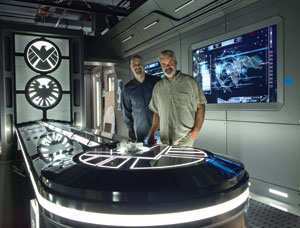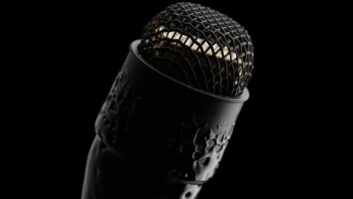
Audio Supervisor Mark Edward Lewis and sound designer Frank Serafine at the New York City exhibition of Marvel’s Avengers: STATION.
Photo: Trel Brock
There seems to be no limit to the number of spinoffs that can be generated from the world of Marvel Comics superheroes. The flood of successful movies, TV shows, videogames and toys derived from the venerable Spider-Man and X-Men franchises shows no signs of subsiding any time soon. But that doesn’t even factor in what’s known as the Marvel Cinematic Universe, which includes three smash Iron Man films, two Thors, two Captain Americas, The Incredible Hulk and, the Big Kahuna of them all, 2012’s Marvel’s The Avengers—featuring all four of those titans—which has racked up worldwide sales of more than $1.5 billion alone. These are heady days indeed for Marvel Entertainment and its corporate parent since 2009, The Walt Disney Company.
But what’s happening now in the basement of the former New York Times building in Manhattan, in a space known as Discovery Times Square, represents an exciting new direction for the MCU—a startlingly creative, interactive multimedia exhibition called Marvel’s Avengers STATION (that’s Science Training and Tactical Intelligence Operative Network; they like their acronyms at Marvel).
The 10,000-square-foot installation, produced by Victory Hill Exhibitions in association with Marvel Entertainment and scheduled to run through January 4, 2015, allows Avengers fans to immerse themselves in a series of high-tech rooms/chambers based around different characters and artifacts associated with the franchise. So, for example, they can see Captain America’s Birth Pod, the Tesseract Portal Device, gaze at a preserved alien Chitauri up close, operate Iron Man’s suit, get lost in star maps of the universe, soar in a flight simulator, witness a particle accelerator in action, and on and on. It blends superhero thrills with real and imagined science.

The principal sound crew on Avengers: STATION, from left—Mark Edward Lewis, Francois Blaignan, Carl Yanchar, Frank Serafine and Nicholas Cooper—at Blaignan’s Los Angeles studio.
Photo: Daniel Keller
Not surprisingly, sound plays an essential role in Avengers STATION, though audio supervisor Mark Edward Lewis says that when he was first approached about working on the project, it was just to do a little film editing work—jack-of-all-trades Lewis’ career includes film and sound editing, re-recording mixing, cinematography, feature and short film direction and 25 years of writing music for film and television. He’d gotten the call from friend and colleague Alec Peters, executive producer of the web feature Star Trek: Axanar, on which Lewis worked, and CEO of Propworx, a company that specializes in Internet auctions of film and TV “assets.”
“So when I get there,” Lewis says, “Alec shows me these elaborate story boards of this incredible Avengers exhibit, with these beautiful renderings, Thor and Hulk and technology like you can’t believe; literally technology that no one has ever seen before. Then I sit down with the executive producer, Nick Cooper [founder and chief creative officer of Victory Hill], and I ask, ‘Who’s doing sound for this?’ He says, ‘Oh, we’re just going to put some ambiences in there.’ ‘So, Iron Man is going to fly in silence?’ I ended up making all these suggestions about sound possibilities, and I walked out as audio supervisor.
“I immediately thought, ‘Oh, my God, what have I done?’” he laughs, “so I called Frank Serafine and asked, ‘Are you available?’ This was going to be like a feature [film] amount of sound design.” Serafine has been a top sound designer (and supervisor) in Hollywood for more than three decades, with credits that include two of the early Star Trek films, Tron, The Hunt for Red October and many others. He signed on as senior sound designer on the STATION project and, in turn, hired sound designer and engineer François Blaignan, who has worked with Serafine for more than 20 years, and noted studio designer and systems engineer Carl Yanchar to be part of what Lewis calls “a dream team of sound support.”
Lewis set up shop in an office in Victory Hill Entertainment’s 50,000 square-foot warehouse space in Valencia, Calif. (north of L.A.), as builders worked around the clock constructing the exhibit, which was assembled and tested there, then shipped to New York in a fleet of semis. Fortunately for the sound team, they weren’t tasked with having to come up with all of the audio for the exhibit from scratch. The music came entirely from various MCU films, and a number of the sound effects, too.

BEFORE: Lewis and Serafine in the test pod during setup for the Iron Man exhibit, in Valencia, Calif.
Photo: Daniel Keller

AFTER: Serafine and Lewis in the nearly finished New York City installation, a few weeks later.
Photo: Trel Brock
“They designated me to go to Disney and work with the Marvel assets group to pull all of the existing predub stems from every one of the Marvel movies we were working with in this exhibit,” Serafine says. “So that was rather extensive. We’d be swapping 4TB drives with each other, and then François would take those elements—these giant predub stems—and basically spread them out. Some of them are up to 250 tracks wide, and in some cases we had to take 250 tracks and bus them to a stereo out. So we needed a lot of Pro Tools and computer power on the audio in order to just hear some of this stuff.
“But I knew what we needed to get to the proper elements, so we could execute this in a timely manner, since we only had one-and-a-half to two months to finish it. And in a lot of cases, we tried to stay close to the original [sounds from the film] because there are going to be so many fans who know these films like the back of their hands.”
Still, the project called for many creative sound design moments, including ones where preexisting effects were layered with new elements, like with the sound of the Tesseract. “And then there are a ton of sounds we had to create from nothing,” Lewis says. “For example, we see Bruce Banner’s brain go from his brain into the Hulk brain, and then back again. There was no sound for that anywhere, so we created it using our own personal libraries. What Marvel is doing in STATION with these sounds is actually changing the lore and establishing canon for the Avengers franchise. That’s exciting.”
In the Induction Room, Serafine was even able to employ an effect he created in the early ’90s for the submarine film The Hunt for Red October. Back then, he got permission from Disneyland to go after-hours into the subterranean underbelly of the park with a Sony PCM F-1 to record the sound of gargantuan master air conditioning turbines being turned on and off. It fit for Red October and, in a different way, more than two decades later, in the STATION.
These days, Serafine is more likely to capture effects with Zoom portable digital recorders, but adds, “I’m also using the Roland R-88 with my Holophone [H2 PRO] microphone for full 3-D sound. Some of the sounds I recorded for the flight simulator are wind sounds I recorded on the R-88. I live up above Los Angeles on 10 acres, and we get really fierce windstorms up here sometimes, so what I’ve been doing is going out and sticking that Holophone head right in the middle of the bushes, and it creates this eight-channel Holophonic wind.” Blaignan works closely with Serafine tailoring the effects and also designing his own, both in his personal studio, and on-site. He was also involved with music editing.
Lewis also did his share of effects recording, including some done right in the Valencia facility. “They built the exhibit in Valencia to test, so naturally they have a shop,” he says. “Twenty-four hours a day there’s noise in there—every kind of shop noise and ambience you can imagine. I’d walk out there with a pair of EX-29 headphones and a Zoom H6 and an MS microphone and get these amazing ambiences. In fact, when you walk into the hallway where you’ll queue for the exhibit, it’s Zoom H6 heaven. Basically everything in there except for the Helicarrier, which is a sound Frank and François pulled from the movie, is H6 recordings.”

BEFORE: Serafine and Lewis at the setup for the particle accelerator in Valencia, Calif.
Photo: Daniel Keller

AFTER: Serafine and Lewis in the NYC installation of the particle accelerator, weeks later.
Photo: Trel Brock
All this talk about effects is well and good, but in truth, the greatest challenge facing the sound team was figuring out how to mix and deliver the audio in the exhibit’s many different environments. “That’s something Carl [Yanchar] and I really worked on a lot,” Lewis says. “We’re still working on it [less than a month before opening in late May]. And when we get to New York, there will be days and days of testing in the actual venue.
“Early on, it was very clear to us that there had been no attention to audio treatment at all. There are no ceilings, all the floors are reflective, all the walls are parallel and reflective. And the designer who created this beautiful, amazing-looking exhibit, really had no intention of wanting to see speakers anywhere. Later, we found out that was okay if it was practical. So that was a challenge. Like in Briefing Room A, which is an all-glass room, we’ll have 60 3.5-inch transducers all around the room mashed into the steel beams that hold the glass panels. It was the only place we could put them and get any directionality. To hide them, we placed them in the same boxes as the laser emitters and had the design department create cool ‘Avengers World’ enclosures that allow maximum emitter angle for the lasers and brought in the 80-400 Hz that we needed. For low-end, we installed two Temblors and acoustically coupled them to the floor outside the room. We had to find a way to both get speakers out of visual space and also minimize primary, secondary and tertiary reflections banging not only all over the room, but also banging into other rooms. So we worked with PreSonus to find a near-field monitor solution.
“So many of the loudspeakers we were testing were just that—loudspeakers meant to broaden the direction and angle of the sound for maximum coverage. Well, we didn’t want that at all. We wanted a narrowing of the sound for very specific audio zones that were directed. There are about 55 of these zones throughout the exhibit. The thing about near-fields is they don’t put out a lot of volume, but we’re in an enclosed exhibit space, and we’re not hitting people with anything over 80 decibels. Even at 20 feet it’s very directional and we are able to pivot the speakers exactly where we want our sound zones to go using these rare speaker mounts that Carl found and the production department customized for us.”
In all, the exhibit utilizes 224 speakers, including PreSonus Eris E8s, Eris E5s, Sceptre S6s and Temblor T10s— “those amazing subwoofers they have,” Lewis says. “Then, out in the queuing area and the gift shop, we’re using JBL Series 3 LSR5s. There are some other speakers we’re using that are passive throughout—like what I call ‘practicals,’ things that Carl pieced together with shop-built enclosures around them.” For extra sub power in certain spots, “because there’s no ceiling and no bass trapping, we decided to use Butt-Kickers—not the big ones, because we don’t have room under the floor, but the mini ones. Once you EQ them in a specific way, they do incredible bass management on specific sub-floor plates. You stand on this thing you’re going to have a ride. If you’re in the Induction Room when the Helicarrier comes by, your tooth fillings had better be well-glued.”
A couple of rooms also used “glass speakers,” which Serafine explains are “transducers that connect to the glass and use the glass as a sounding board, so all you see on this 8-foot piece of glass that weighs something like 300 pounds is a little transducer, and its like you’re hearing the sound come right out of the glass.”
The large number of different-size loudspeakers and the wide variety of actual and implied sources of those sounds required a multiplicity of mixing and delivery approaches for the immersive audio effects. As Lewis notes, “We have everything from 7.1 down to mono. Some of the ambiences are 6.1. Some are stereo with bass management. Then you’ve got things like apparatuses in Iron Man, which are LCR.1. Every mix is like doing your own crazy little mini-movie in its own strange surround format, and every mix is different. Because each room has a completely different audio reflectivity, phasing and absorption, the real mixing will happen in the exhibit. Every channel has DSP of some kind, so we can get into each apparatus and tune, EQ, compress and do whatever we need to do to make the sound uniform throughout.

Two of the dozens of PreSonus Eris E5 studio near-fields being positioned in Valencia, Calif. They will later be mounted and concealed in the New York City installation.
“One thing we’ve been using that is interesting are Raspberry Pi’s—an amazing little $65 computer that’s the size of your fist, but has enough computing power to run six channels of audio, or a 4K monitor with stereo audio, all on a little chip,” he continues. “There’s no hard drive—it’s running Linux and it’s amazing. You turn them on, there are no moving parts, they’re indestructible. They have an extra audio board so you can get HDMI out, or more robust audio out. So we’re using those for anything that is audio looped that has no connection to show control.
“Then we’re also using a company named 2-Bit Circus for our show control. They’re running their proprietary show control code on Mac minis. Multichannel audio comes out of those Macs on PreSonus AudioBox 1818VSLs. We’re running up to eight channels of discrete outputs on those machines. But, the STATION interface and user interactivity programmers at Brightline Interactive are using HP workstations. Those workstations are also using the PreSonus AudioBox 1818VSLs. The issue was finding an interface that could not only work on both Mac and PC, but also had super-solid drivers for both operating systems, had DSP on each channel, and allowed us access to all their features.”
Adds Serafine, “The 1818 also allows us to do a Wi-Fi connection and control all the interfaces, which are going to be very hard to get to when we get to New York because they’re stacked behind these walls with limited access. So we’ll be able to mix our DSP with an iPad in the actual environment.”
The compressed work schedule on the project had everyone on the sound crew tackling multiple roles outside the usual domains of audio post. For instance, the group ended up creating an important visual effect for the Tesseract, using an iZotope spectral analyzer from RX-3 and a Symbolic Sound Kyma synthesizer to reproduce spectral curves provided by NASA. And later in the project, they were called upon to add some voiceover parts, recorded at Steve Robertson’s Filmmakers Sanctuary Studios in Castaic (near Valencia) and at Blaignan’s studio.
This selfless and efficient collaborative approach was essential to completing the project on time, and as usual, the thousands of happy Avengers fans who will stream through the exhibit in New York (and perhaps other cities as well, later) will be blissfully ignorant of the creativity that went into its creation and the technology behind the walls. That’s a superhero feat in itself.







